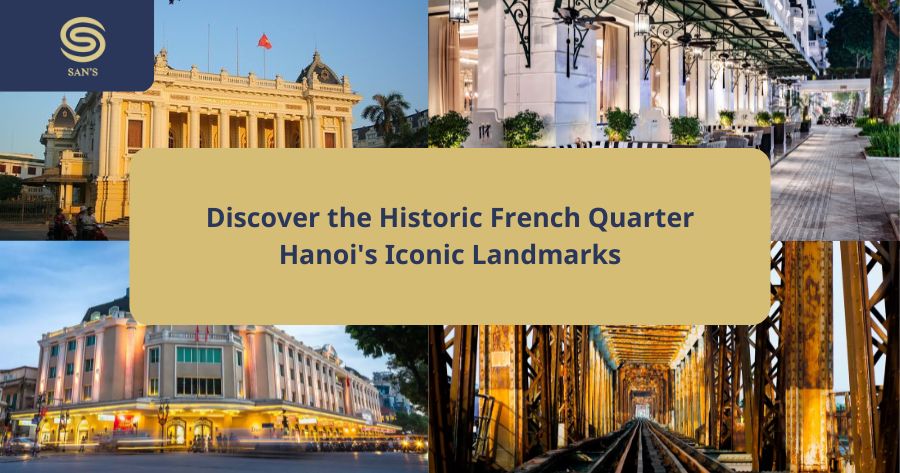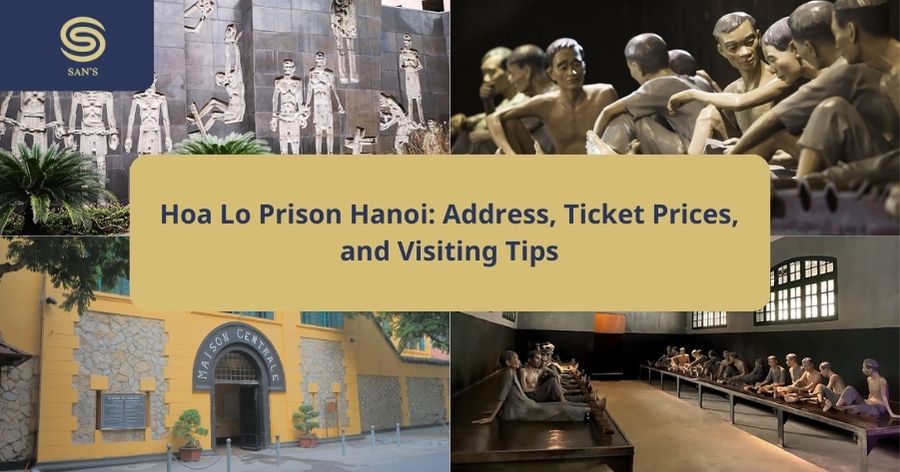Tucked away from the vibrant, bustling streets of Hanoi’s Old Quarter lies a peaceful haven where history, architecture, and culture come together harmoniously – The French Quarter. Known locally as “Khu phố Pháp,” the French Quarter of Hanoi offers visitors a glimpse into the city’s colonial past while retaining a unique charm that sets it apart from other neighborhoods in Vietnam. In this guide, Sanhotelseries will take you through the key landmarks, the best places to explore, and tips for making the most of your visit to the French Quarter Hanoi.
History of the French Quarter in Hanoi
The French Quarter was established during the French colonial period in the late 19th century when Hanoi became the capital of French Indochina. This area was strategically designed to reflect European grandeur and served as the administrative and political hub for the French colonial government. The French Quarter stands as a testament to this era, with its neoclassical and art deco buildings that blend French architectural styles with Vietnamese elements.
Architectural Style
The architecture of the French Quarter is characterized by its wide boulevards, elegant French villas, and stately government buildings. The French influence is evident in the grand facades, decorative balconies, and shaded streets that provide a serene contrast to the chaotic energy of Hanoi’s Old Quarter. These buildings, many of which are still in use today, represent a unique fusion of French and Vietnamese cultures, showcasing the architectural sophistication that once dominated the city’s urban planning.
Cultural Influence
Beyond the architecture, the French Quarter has influenced Hanoi’s lifestyle, cuisine, and culture. Cafes offering French pastries and strong Vietnamese coffee dot the streets, while French-inspired gardens and public squares provide quiet retreats from the busy city. The urban planning of the French Quarter introduced modern infrastructure, from wide sidewalks to street lighting, which still contributes to the area’s appeal today.
Iconic Landmarks of the French Quarter Hanoi
Below are the iconic landmarks of Hanoi’s French Quarter that you should visit once in your life.
Hanoi Opera House
One of the most iconic landmarks in the French Quarter is the Hanoi Opera House. Built in 1911, this architectural masterpiece was modeled after the Palais Garnier in Paris and remains one of the finest examples of French colonial architecture in Southeast Asia. The opera house has played a central role in Hanoi’s cultural scene, hosting everything from opera and ballet to modern performances.

Fun Fact: The Hanoi Opera House was where Vietnam’s independence was declared in 1945.
Tourist Tips: The best time to visit the Opera House is during a performance. Even if you’re not attending a show, the surrounding cafes, like the elegant Highlands Coffee nearby, offer stunning views of the building’s grand facade. It’s recommended to visit in the late afternoon to capture beautiful photos in the golden hour light.
Sofitel Legend Metropole Hotel
Another must-visit location is the Sofitel Legend Metropole Hotel, a historic luxury hotel that has hosted numerous famous guests, including Charlie Chaplin and Graham Greene. Built in 1901, this hotel is more than just a place to stay—it’s a living piece of history, offering guests a chance to step back into the elegance of the early 20th century.

Experience: Indulge in afternoon tea at the Metropole’s Le Club Bar or dine at their legendary French restaurant, Le Beaulieu, for an experience that captures the charm and sophistication of Hanoi’s French Quarter.
Notable Guests: Charlie Chaplin celebrated his honeymoon here, and the hotel is often frequented by diplomats and celebrities visiting Hanoi.
St. Joseph’s Cathedral
For a touch of Gothic Revival architecture, head to St. Joseph’s Cathedral, located just outside the French Quarter. This imposing structure, built in 1886, resembles the Notre Dame Cathedral in Paris and is one of the oldest Catholic churches in Hanoi. The cathedral is an important religious and cultural site for both locals and visitors.

Tourist Tips: Visit early in the morning or late in the afternoon to avoid crowds and enjoy a peaceful moment. There are many charming cafes nearby where you can relax and enjoy the view, such as La Place Cafe, offering great views of the cathedral.
Hoàn Kiếm Lake and Surrounding Area
Hoàn Kiếm Lake serves as the boundary between the French Quarter and the Old Quarter, offering a peaceful respite from the city’s busy streets. Surrounding the lake are several historical landmarks, including the Ngọc Sơn Temple and the iconic The Huc Bridge.

Walk Around: Stroll along the boulevards surrounding the lake, such as Trang Tien and Phan Chu Trinh streets, where the French architecture and leafy trees provide a serene atmosphere for a leisurely walk. This area perfectly showcases the elegant, French-inspired urban planning that characterizes the French Quarter.
Other Notable Buildings and Streets in the French Quarter
In addition to the iconic landmarks of Hanoi’s French Quarter, you can visit other notable buildings and streets listed below.
Presidential Palace
The Presidential Palace, with its neoclassical design, is one of the most recognizable buildings in the French Quarter. Originally built to house the Governor-General of French Indochina, this building is now used for official ceremonies. The grand yellow facade and manicured gardens are a testament to the area’s colonial past.

Trang Tien Street
Trang Tien Street is one of the most famous streets in the French Quarter, lined with high-end boutiques, French-influenced cafes, and cultural landmarks like the Hanoi Opera House. It’s a popular spot for both shopping and sightseeing, offering a luxury shopping experience in the heart of Hanoi.

Le Club Bar (Metropole Hotel)
If you’re looking for a luxurious spot to unwind, the Le Club Bar inside the Metropole Hotel offers old-world charm combined with exceptional service. It’s the perfect place to enjoy a cocktail while soaking in the ambiance of one of Hanoi’s most historic hotels.

Long Bien Bridge
Designed by Gustave Eiffel, the Long Bien Bridge is an iconic structure that connects the French Quarter with Hanoi’s surrounding areas. While not directly within the French Quarter, it serves as a key link to the city’s history, reflecting the architectural grandeur of the French colonial period.

Tips for Exploring the French Quarter Hanoi
- Best Time to Visit: The best times to explore the French Quarter are early morning and late afternoon when the light is soft, and the streets are less crowded, offering great photo opportunities.
- Transportation:
- Walking: Many of the French Quarter’s key landmarks are within walking distance of each other, making it easy to explore on foot. Check out the walking tour of the French Quarter here!
- Bicycle: For a more scenic experience, rent a bicycle to leisurely ride along the wide boulevards and tree-lined streets.
- Jeep Tours: Consider booking a vintage jeep tour to explore the area in style.
- Tour Bus: If you’re short on time, opt for a city tour bus that includes the French Quarter in its itinerary.
Conclusion
The French Quarter Hanoi offers an unparalleled glimpse into the city’s past, with its elegant colonial architecture, wide boulevards, and rich cultural heritage. From the iconic Hanoi Opera House to the luxurious Sofitel Legend Metropole Hotel, each landmark tells a story of a time when French influence shaped the city’s landscape. Whether you’re a history buff, an architecture enthusiast, or simply someone who enjoys the finer things in life, the French Quarter Hanoi is a destination that should not be missed.
As you plan your visit to Hanoi, we invite you to experience the French Quarter’s timeless elegance firsthand. Book your stay at Sanhotelseries, located in the heart of Hanoi, and enjoy a luxurious and comfortable experience while exploring all that the French Quarter has to offer. If you visit Vietnam and the capital Hanoi, you can book a room at San Hotel for the best prices here!
Follow us on Facebook to update the latest travel information daily: San Hotel Series





